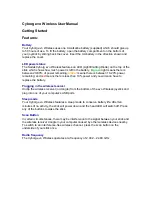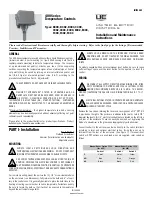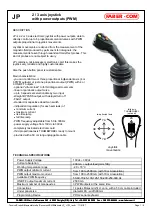
5-20
How to Operate
1) Bring the motor to stall (Servo-off).
2) Set up Pr0.02
(Setup of real-time auto-gain tuning mode) to other than 0, 6.
Setup
value
Real-time auto-gain
tuning
Explanation
0
Invalid
Real-time auto-gain tuning function is disabled.
1
Synchronous
Synchronous control mode.
Do not use this mode for unbalanced load or friction
compensate. Use this mode first when maintaining command
response filter, then switch to another mode as necessary.
2
Synchronous friction
compensation
With dynamic friction compensation/viscous friction
compensation in addition to those of synchronous mode. Use
this mode when the load has a large friction.
3
Stiffness setting
Use this mode when modifying gain filter setting according
to stiffness table without making inertia ratio assumption,
unbalanced load compensation or friction compensation.
When handling a load with larger inertia variations, first
estimate inertia in an appropriate mode, e.g. sync mode, and
then switch to this mode.
4
Load characteristics
update
Use this mode when applying only inertia ratio, dynamic friction
compensation and viscous friction compensation among load
characteristics while holding gain filter setting.
5
Load characteristic
measurement
Estimate load characteristics without changing basic gain
setting or friction compensation setting with the help of the
setup support software.
6
Load fluctuation
response mode
Use this mode when you wish to make robust adjustments for
fluctuating loads.
Control parameter is automatically set according to Pr0.03 Real-time auto-tuning stiff-
ness setup.
[Example of real-time auto-tuning setup]
When using this function for the first time with multijoint robot, set initial stiffness to
a lower value in accordance with the load capacity in the synchronous friction com-
pensation mode (Pr0.02 = 2), and incline the arm by 45 degrees, and then estimate
the load characteristics with short distance reciprocating running (1-2 rotations of
motor shaft).
To see effects of quadrant switching due to friction compensation, try Pr0.02 = 1.
To perform only load characteristics estimation, use the load characteristic update
mode Pr0.02 = 4.
Because the inertia ratio and resonance characteristic of multijoint robot vary with
orientation, disable the auto-tuning (Pr2.00 = 0) after estimation of load characteris-
tics. In the load characteristic measurement mode (Pr0.02 = 5), the load characteris-
tic change due to arm orientation can be observed without affecting operation.
When adjusting during operation, enter the stiffness setup mode (Pr0.02 = 3). While
holding load characteristic compensation, change the stiffness setting and check lo-
cus accuracy and positioning performance.
2. Real-Time Auto-Gain Tuning
Two-degree-of-freedom control mode – Synchronous type
Note
Related page
• While the auto-tuning is valid, parameters that are to be automatically adjusted cannot be
changed.
• P.4-6 to P.4-85... “Details of parameter”
Buy: www.ValinOnline.com | Phone 844-385-3099 | Email: [email protected]
















































